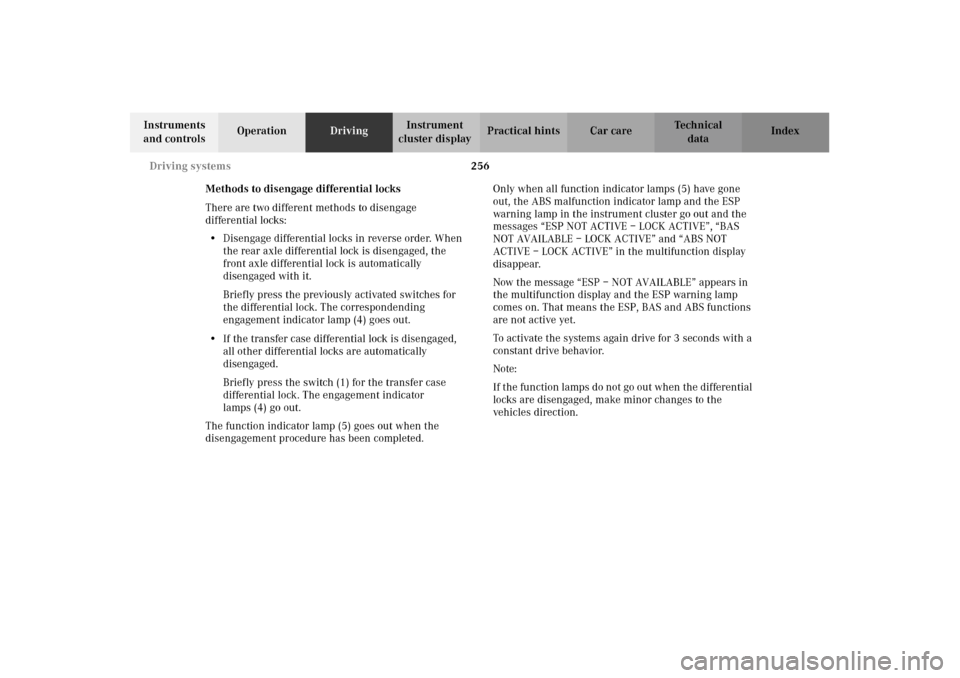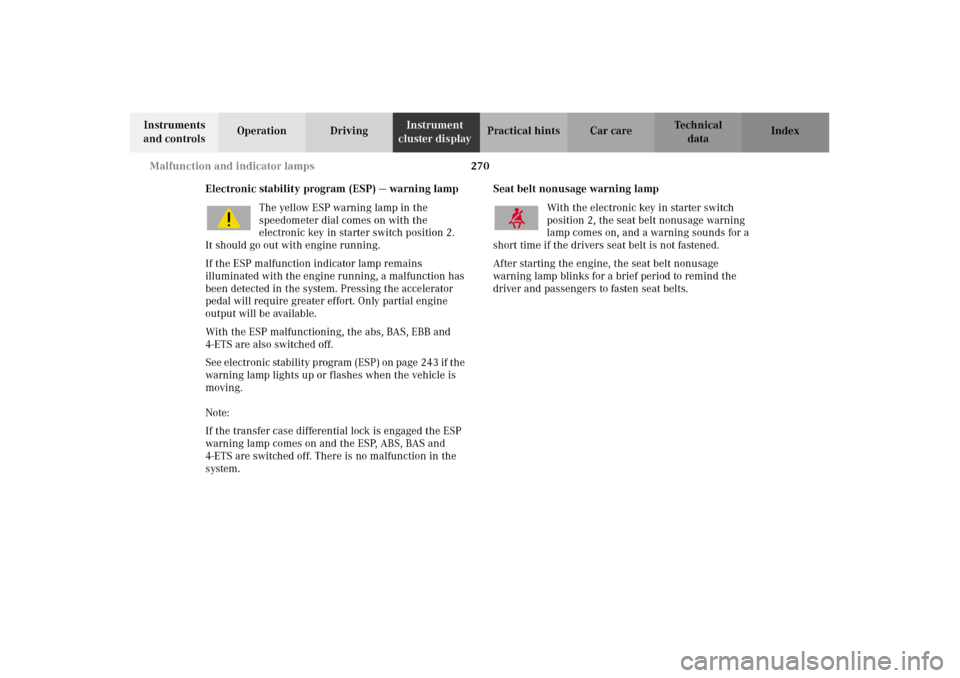Page 255 of 385
252 Driving systems
Te ch n i c a l
data Instruments
and controlsOperationDrivingInstrument
cluster displayPractical hints Car care Index
It is important to understand that during on-road/paved
driving, differentials are absolutely required to provide
essential control and steering ability of the vehicle. The
differential locks, therefore, must not be engaged when
driving on paved roads and should only be used when
and to the extent necessary to negotiate off-road
conditions not addressable by the systems (automatic
ETS, ESP; manual switch position “LOW” of transfer-
case) this vehicle comes equipped with.
J_G463.book Seite 252 Mittwoch, 19. September 2001 8:06 08
Page 256 of 385
253 Driving systems
Te ch n i c a l
data Instruments
and controlsOperationDrivingInstrument
cluster displayPractical hints Car care Index Differential locks
The switch is located in the center console.
1Transfer case (center) differential lock
2Rear axle differential lock
3Front differential lock
4Engagement indicator lamps (yellow)
5Function indicator lamp (red)6 The ESP, BAS and ABS are switched off
The differential locks can only be switched on in the
following sequence.
•Transfer case differential lock
•Rear axle differential lock
•Front differential lock
J_G463.book Seite 253 Mittwoch, 19. September 2001 8:06 08
Page 257 of 385

254 Driving systems
Te ch n i c a l
data Instruments
and controlsOperationDrivingInstrument
cluster displayPractical hints Car care Index
Important!
Do not engage the front axle differential lock when
driving around tight corners as steering ability is
restricted.
When the transfer case differential lock is activated, the
ESP, ABS and BAS are automatically switched off.
The ABS malfunction indicator lamp and the ESP
warning lamp in the instrument cluster come on.
Further appear alternately the messages “ESP NOT
ACTIVE – LOCK ACTIVE”, “BAS NOT AVAILABLE –
LOCK ACTIVE” and “ABS NOT ACTIVE – LOCK
ACTIVE” in the multifunction display.
The differential locks should be engaged when driving
off-road, for example:
•for driving trough water or
•when driving on deep snow, icy or fouled surfaces.
For notes on off-road driving, see page 226.To engage differential locks:
Important!
To avoid damage to the transfer case and differential
locks:
• Engage differential locks only at low speed
(walking speed, not more than 5 mph).
• Do not engage differential locks if the driving
wheels are spinning.
Wa r n i n g !
Never drive on pavement with activated differential
locks.
J_G463.book Seite 254 Mittwoch, 19. September 2001 8:06 08
Page 258 of 385
255 Driving systems
Te ch n i c a l
data Instruments
and controlsOperationDrivingInstrument
cluster displayPractical hints Car care Index Briefly press the switch for the differential lock
required. The corresponding engagement indicator
lamp (4) comes on.
The ESP warning lamp in the instrument cluster comes
on and the message “ESP NOT ACTIVE – LOCK
SELECTED” appears.The function indicator lamp (5) comes on when the
differential lock engagement procedure has been
completed. The ABS malfunction indicator lamp and the
ESP warning lamp in the instrument cluster come on.
Further appear alternately the messages “ESP NOT
ACTIVE – LOCK ACTIVE”, “BAS NOT AVAILABLE –
LOCK ACTIVE” and “ABS NOT ACTIVE – LOCK
ACTIVE” in the multifunction display.
Only apply the accelerator lightly when driving off.
J_G463.book Seite 255 Mittwoch, 19. September 2001 8:06 08
Page 259 of 385

256 Driving systems
Te ch n i c a l
data Instruments
and controlsOperationDrivingInstrument
cluster displayPractical hints Car care Index
Methods to disengage differential locks
There are two different methods to disengage
differential locks:
•Disengage differential locks in reverse order. When
the rear axle differential lock is disengaged, the
front axle differential lock is automatically
disengaged with it.
Briefly press the previously activated switches for
the differential lock. The correspondending
engagement indicator lamp (4) goes out.
•If the transfer case differential lock is disengaged,
all other differential locks are automatically
disengaged.
Briefly press the switch (1) for the transfer case
differential lock. The engagement indicator
lamps (4) go out.
The function indicator lamp (5) goes out when the
disengagement procedure has been completed.Only when all function indicator lamps (5) have gone
out, the ABS malfunction indicator lamp and the ESP
warning lamp in the instrument cluster go out and the
messages “ESP NOT ACTIVE – LOCK ACTIVE”, “BAS
NOT AVAILABLE – LOCK ACTIVE” and “ABS NOT
ACTIVE – LOCK ACTIVE” in the multifunction display
disappear.
Now the message “ESP – NOT AVAILABLE” appears in
the multifunction display and the ESP warning lamp
comes on. That means the ESP, BAS and ABS functions
are not active yet.
To activate the systems again drive for 3 seconds with a
constant drive behavior.
Note:
If the function lamps do not go out when the differential
locks are disengaged, make minor changes to the
vehicles direction.
J_G463.book Seite 256 Mittwoch, 19. September 2001 8:06 08
Page 260 of 385
257 Driving systems
Te ch n i c a l
data Instruments
and controlsOperationDrivingInstrument
cluster displayPractical hints Car care Index Important!
When running on a (single-axle) dynamometer – no
matter how briefly – the non driven axle must be
raised or its drive shaft disconnected. The transfer
differential lock must be engaged. Otherwise the
transfer case can be damaged, which is not covered
by the Mercedes-Benz Limited Warranty.
Wa r n i n g !
Never drive on pavement with activated differential
locks.Steering control will be strongly affected with the
front differential lock activated.ABS, BAS and ESP are switched off automatically
when the transfer case differential lock is
activated.
J_G463.book Seite 257 Mittwoch, 19. September 2001 8:06 08
Page 272 of 385

269 Malfunction and indicator lamps
Te ch n i c a l
data Instruments
and controlsOperation DrivingInstrument
cluster displayPractical hints Car care Index ABS malfunction indicator lamp
The ABS malfunction indicator lamp in the
instrument cluster comes on with the
electronic key in starter switch position 2
and should go out with the engine running.
When the ABS malfunction indicator lamp symbol and
warning in the instrument cluster remains illuminated
while the engine is running, it indicates that the ABS
has detected a malfunction and has switched off. In this
case, the brake system functions in the usual manner,
but without antilock assistance.
A malfunctioning ABS control unit can possibly affect
the operation of other systems (e.g. Navigation,
Automatic transmission). Be guided accordingly with
respect to the use of those systems and have the system
checked at your authorized Mercedes-Benz Light Truck
Center as soon as possible.
With the ABS malfunctioning the BAS, ESP, EBB and
4-ETS are also switched off. The malfunction indicator
lamps and malfunction messages in the multifunction
display come on with the engine running.If a warning tone sounds for 5 seconds and the warning
lamps- and É are displayed in the instrument
cluster, the EBB has a malfunction and is switched off.
See page 242 for notes on the electronic brake booster
(EBB).
If the charging voltage falls below 10 volts, the
malfunction indicator lamp comes on and the ABS is
switched off. When the voltage is above this value again,
the malfunction indicator lamp should go out and the
ABS is operational.
Have the system checked at your authorized
Mercedes-Benz Light Truck Center as soon as possible.
See page 239 for notes on antilock brake system (ABS).
Note:
If the transfer case differential lock is engaged the ABS
warning lamp comes on and the ABS, ESP, BAS, EBB
and 4-ETS are switched off. There is no malfunction in
the system.
ABS
J_G463.book Seite 269 Mittwoch, 19. September 2001 8:06 08
Page 273 of 385

270 Malfunction and indicator lamps
Te ch n i c a l
data Instruments
and controlsOperation DrivingInstrument
cluster displayPractical hints Car care Index
Electronic stability program (ESP) — warning lamp
The yellow ESP warning lamp in the
speedometer dial comes on with the
electronic key in starter switch position 2.
It should go out with engine running.
If the ESP malfunction indicator lamp remains
illuminated with the engine running, a malfunction has
been detected in the system. Pressing the accelerator
pedal will require greater effort. Only partial engine
output will be available.
With the ESP malfunctioning, the abs, BAS, EBB and
4-ETS are also switched off.
See electronic stability program (ESP) on page 243 if the
warning lamp lights up or flashes when the vehicle is
moving.
Note:
If the transfer case differential lock is engaged the ESP
warning lamp comes on and the ESP, ABS, BAS and
4-ETS are switched off. There is no malfunction in the
system.Seat belt nonusage warning lamp
With the electronic key in starter switch
position 2, the seat belt nonusage warning
lamp comes on, and a warning sounds for a
short time if the drivers seat belt is not fastened.
After starting the engine, the seat belt nonusage
warning lamp blinks for a brief period to remind the
driver and passengers to fasten seat belts.
J_G463.book Seite 270 Mittwoch, 19. September 2001 8:06 08